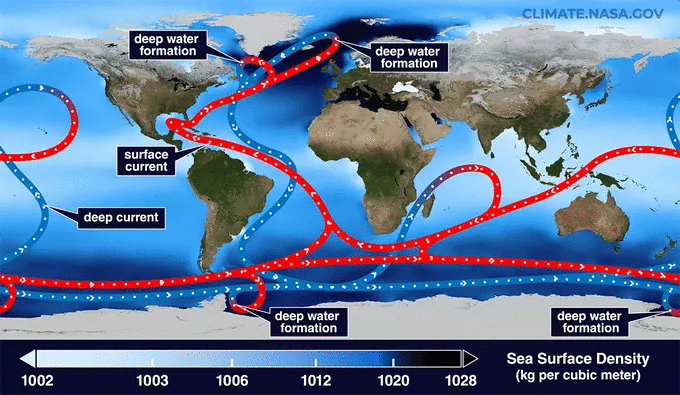The Gulf Stream could collapse by 2025, leading to chaos in Earth’s climate. Storms will “proliferate” around the globe.
Researchers predict that the Atlantic Meridional Overturning Circulation (AMOC) could collapse at any time between 2025 and 2095, much earlier than previous estimates.
AMOC is a current that governs Earth’s climate by transporting warm tropical waters northward and cold waters southward.
This is a crucial ocean current system that helps regulate the climate of the Northern Hemisphere, but it could collapse at any moment from 2025, causing climate chaos.
Researchers indicate that AMOC could completely collapse between 2025 and 2095, resulting in drastic changes in the ocean ecosystem, a significant temperature drop, and storms that will “proliferate” worldwide.
AMOC exists in two stable states: a strong, fast state and a weak, slow state.
Previous studies predicted that the ocean current might shift to a weak mode at some point in the coming century. However, human-induced climate change may hasten AMOC’s collapse.
Professor Susanne Ditlevsen from the University of Copenhagen (Denmark), the lead author of the study, stated: “The collapse of AMOC may occur much sooner than expected, as humans are emitting greenhouse gases at alarming rates.”
AMOC is like a global conveyor belt
The Atlantic currents operate like an endless global conveyor belt, moving oxygen, nutrients, carbon, and heat around the Earth.

AMOC functions like a “conveyor belt,” with surface currents shown in red and deep currents in blue. (Photo: Live Science).
AMOC causes warm, salty, and dense water from the south to flow north to cool and sink below the waters at higher latitudes, releasing heat into the atmosphere.
This current then gradually moves southward and warms back up, a process that occurs cyclically. However, global climate change is slowing down the flow’s activity.
Additionally, freshwater from melting icebergs is making the flow less dense and decreasing its salinity. Recent studies have indicated that this ocean current is at its weakest in the last 1,000 years.
The area near Greenland, where southern seas sink (known as subpolar currents), is experiencing record low temperatures. Meanwhile, the waters surrounding are rising to the highest temperatures in history, creating an ever-expanding “cold spot.”
The last time AMOC switched modes was during the Quaternary Ice Age, about 2 million years ago, when the climate near Greenland increased by 10-15 degrees Celsius within a decade. If this flow collapses, temperatures in Europe and North America could drop by up to 5 degrees Celsius.
Scientists have built a statistical model to assess the diminishing strength and resilience of the ocean current based on its increasing fluctuations year by year.
The results have left the research team concerned; the collapse of this system could begin as early as 2025 and is likely to occur by the end of the 21st century.
Climate Professor Peter Ditlevsen from the Niels Bohr Institute, Copenhagen (Denmark), shared: “These results frighten me because the scenario for this collapse is alarmingly close, and AMOC is crucial for Earth’s climate, so we must act immediately.”
Many oceanographers and climate experts have weighed in on the research, indicating that it serves as a troubling warning.
However, they have cast doubt on these findings, stating that the research is entirely unclear and lacks certainty.
“Although the team’s model is quite realistic, its physical foundation is extremely shaky; simply put, we do not know, and there is no serious discussion to address the shortcomings of the model proposed by the scientists,” stated Jochem Marotzke, director of the Max Planck Institute for Meteorology, Hamburg (Germany).
The study was published on July 25 in the journal Nature Communications.



















































